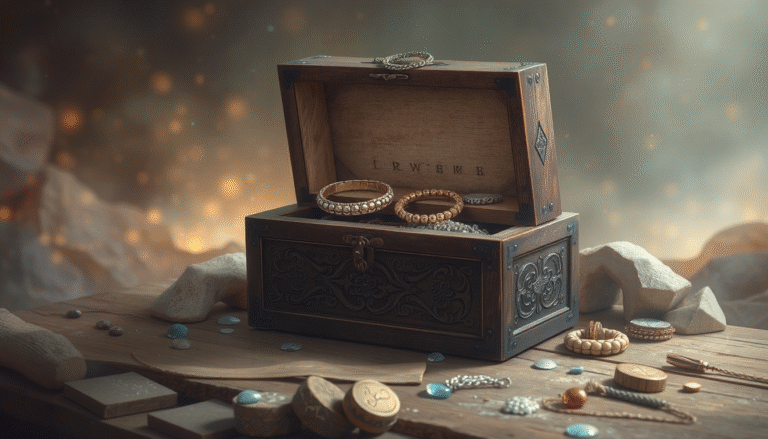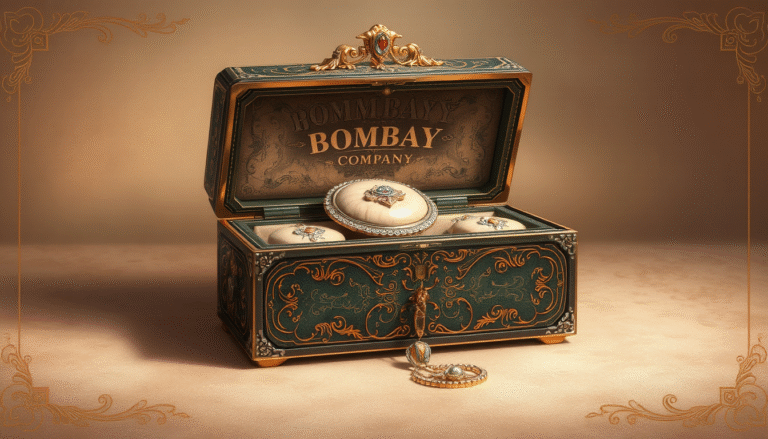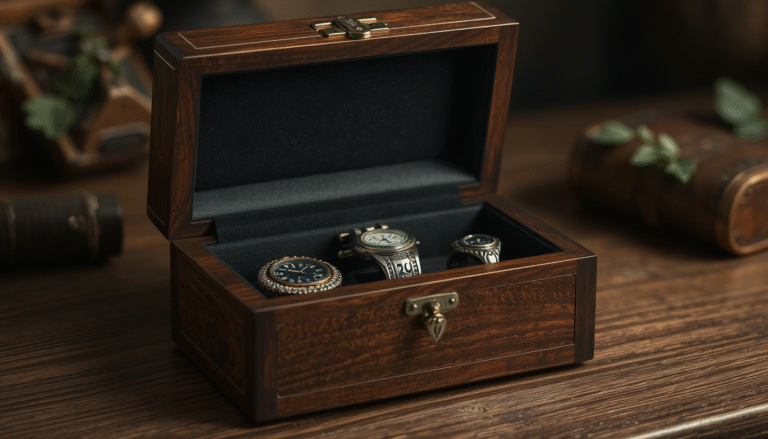Introduction: More Than Just Storage, a Legacy in Wood
These are not just boxes. A Chinese wood jewelry box is a miniature treasure chest that shows careful craftsmanship, deep history, and rich meaning.
It’s a classic caddy consisting of intricate woodwork that is commonly assembled without nails and screws at all. These boxes are handcrafted with fine woods and decored with meaningful designs that reflect aspects of Chinese culture and beliefs.
For that, we have created this guide that you can use as a comprehensive information source to these special boxes. We will explore the materials and age-old skills it takes to create them, demystifying what their beautiful images mean, and also teach you to spot and care for these amazing works of art that are functional too.
The Soul of the Box: A Journey Through Materials and Craftsmanship

The worth of a Chinese jewelry box begins with what it is constructed of and who produced it. The choice of wood is never accidental – it has something to say about quality and tradition.
The Language of Wood: Prized Timbers in Chinese Craft
In Chinese box-making, the wood had its own language. Selecting a certain type of wood gives you information about who the owner was: How”important” he was and what the box was made for. Some woods were exclusive to the emperor, while others were specifically selected for their protective properties.
| Wood Type | Characteristics | Common Use & Significance |
| Rosewood (花梨木) | Deep reddish-brown, dense, fragrant, beautiful grain. | Prized for high-end furniture and boxes; signifies wealth and elegance. |
| Camphor Wood (樟木) | Light-colored, distinct pleasant aroma, naturally insect-repellent. | Excellent for storage chests and jewelry boxes to protect valuables. |
| Zitan (紫檀木) | Extremely dense, purplish-black, so dense it sinks in water. | Historically the most valued wood, reserved for imperial use. Rare today. |
| Elmwood (榆木) | Strong, durable, with a dramatic, wavy grain. | A common and beautiful choice for everyday and fine-quality pieces. |
The Art of the Join: Crafting Without Nails
One amazing thing about traditional Chinese woodworking is that it hardly uses any nails or glue. Instead, it uses a clever system of joints called sǔn mǎo (榫卯).
This method uses precisely cut, interlocking parts that fit together like a 3D puzzle, making the structure incredibly strong. These joints also allow the wood to expand and contract with humidity changes without damaging the box. You can see examples of these traditional Chinese joinery techniques in museums around the world.
Beyond the Wood: Decorative Embellishments
The decorations identify each box but the wood is the foundation. These additional elements receive just as much of the same thoughtful attention as the box itself.
- Lacquerware: The ancient practice includes applying multiple thin layers of lacquer, a natural resin. It is usually red or black and may be polished to a shine or carved with intricate patterns.
- Brass Hardware: The metal parts of a Chinese wood jewelry box aren’t just practical – they’re decorative too. Hinges, corners, handles, and locks are hand-cut from brass, often shaped as symbols like butterflies for love or bats for good luck.
- Jade & Stone Inlays: The fanciest boxes may have inlays with jade, mother-of-pearl, or other stones. They bring color and luxury, naturally, but they can also bring a stone’s symbolic meaning — jade, for example, for purity and protection.
Decoding the Artistry: What the Symbols on Your Jewelry Box Mean
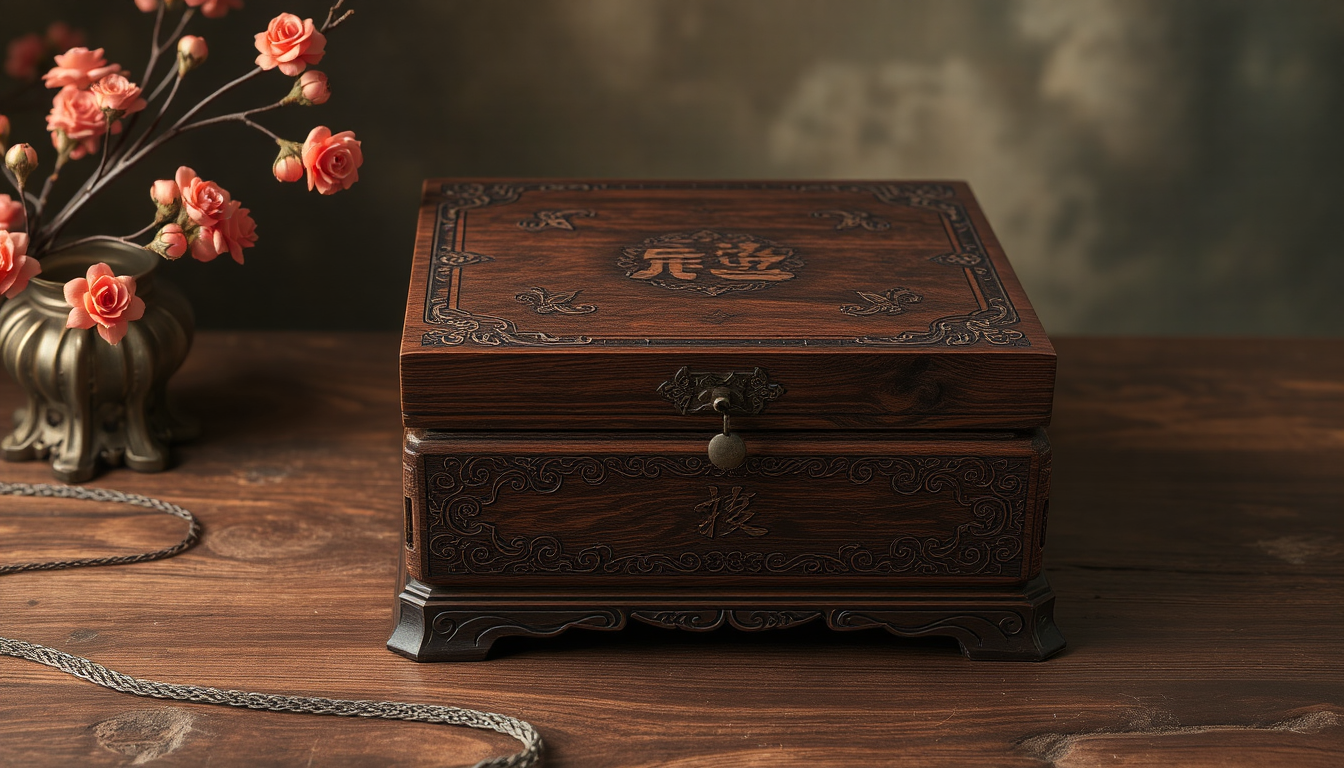
The designs carved or painted on a Chinese wood jewelry box aren’t just pretty decorations. They form a rich vocabulary of symbolic motifs, a visual language of blessings and cultural beliefs. Understanding these symbols turns the box from a beautiful object into a meaningful story.
Mythical Guardians and Imperial Power
Dragon (龙): The dragon is the strongest of the symbols, symbolizing the emperor, heavenly power, strength, and good luck. A dragon perched on a box signifies high status and protection.
Phoenix (凤凰):The phoenix is the dragon’s opposite. It is the empress, the beauty, the virtue, and the happy marriage. When depicted alongside a dragon, they signify a perfect match, and are given as wedding gifts.
Blessings from the Natural World
Chinese art has always been closely inspired by nature. Every flower and creature harbors a particular wish, or symbolizes a desirable quality.
- Peony (牡丹): Called the “king of flowers,” the peony represents wealth, prosperity and honor. Its blossoming symbolizes abundance and honor.
- Lotus (莲花): Coming out of mud unstained, lotus is significant in Buddhism symbolizing spiritual growth, purity, and new life.
- Bamboo (竹): Known to bend in the wind, but not to break, the bamboo represents a person of integrity; it is symbolic of supplement and sexual purity and integrity.
- Crane (鹤): It is believed that a crane can live for a thousand years, and it symbolizes long life and wisdom. A couple of cranes represent a happy and long marriage.
Symbols of Happiness and Fortune
Some symbols are puns, where the name of the object rhymes with, or otherwise suggests, a word for a blessing.
Bat (蝠): The Chinese word for bat sounds the same as good fortune. Five bats is a homonym for the Five Blessings, which are health, wealth, longevity, virtue and a peaceful death.
“Shou” (寿) Character: Character The written character for long-life is turned into hundreds of styles/design to decorate and incorporated into designs to act as a direct wish for long-life.
A Collector’s Eye: How to Identify an Authentic Vintage Chinese Wood Jewelry Box
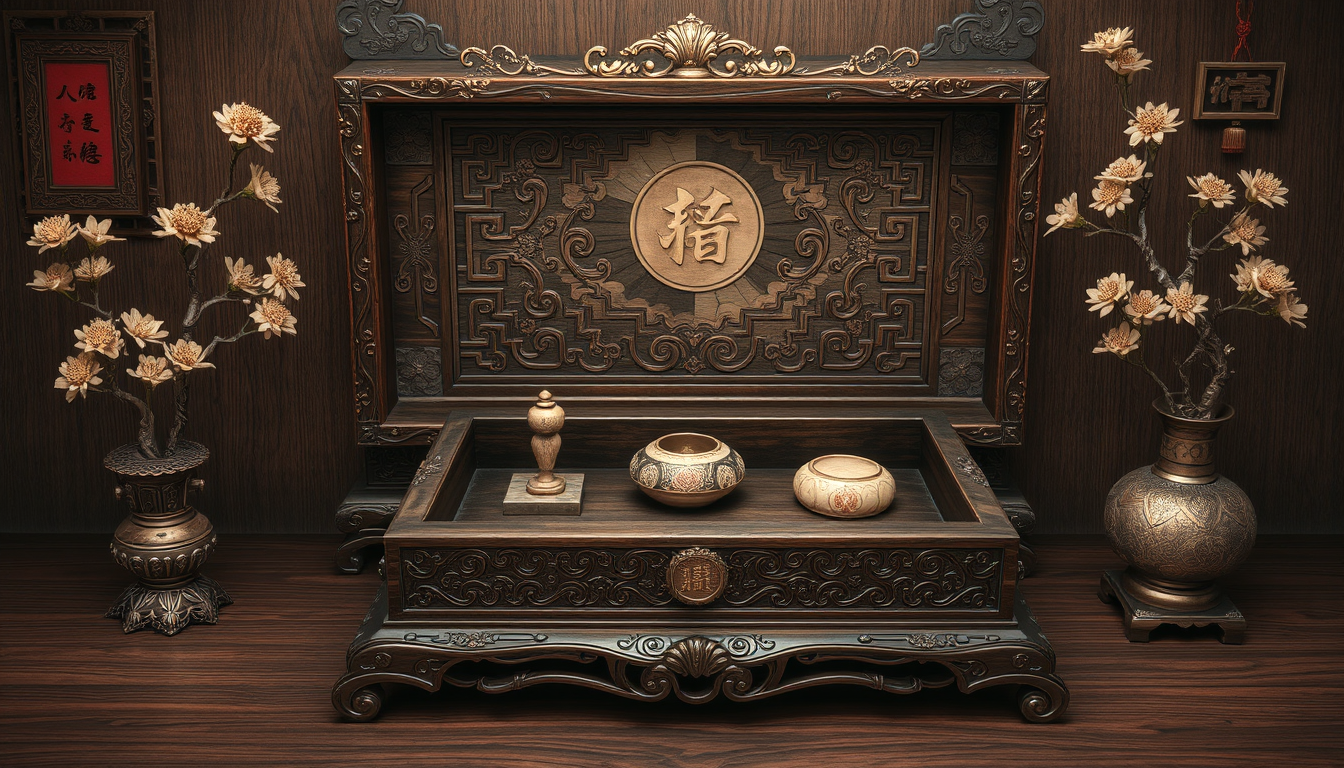
Telling a real vintage piece from a modern copy takes a trained eye. Here are the key things to look for.
Read the Grain: Examining the Wood and Patina
First, check the wood itself. Check around the corners and edges, and if the wood grain runs throughout the piece, you can tell it’s solid wood. These days, current boxes often get veneer of thin wood “sheets” put over some other more abundant material.
Then there’s the patina, the soft, warm glow that wood and brass acquire after decades of use. A true patina is not the same all over; it will be more intense in places where the object was handled the most, around locks, say, or on lid edges. If a box is uniformly shiny or if the aging seems fake near the corners, it’s likely new.
Inspect the Hardware and Joinery
You can learn a lot about age from hardware. Old brass hardware would typically have been hand-cut and you may see irregularities or slight differences. The color will be more of a deep gold, rather than the bright yellow of new brass. Antique locks are plain with escutcheons.
Watch the corners very closely.” Run your fingers over them to ensure they can pass a traditional joint test. No nails or modern screws is one of the best indications of old time workmanship.
Look for Clues of Age and Origin
Open the drawers and the lid tosee inside. Old silk or paper linings faded or worn in places are signs of age. One such: bright, perfect, synthetic fabric is a very modern characteristic.
Don’t fret if you don’t find a maker’s mark. Given most older pieces were manufactured in small workshops (and not signed), this is less common but everything has a first that leads to a second and so on. But some boxes dated 1912-1949, or later, may come with paper labels or small stamps from workshops in places like Shanghai or Hong Kong.
Caring for Your Treasure: Simple Steps for Preservation
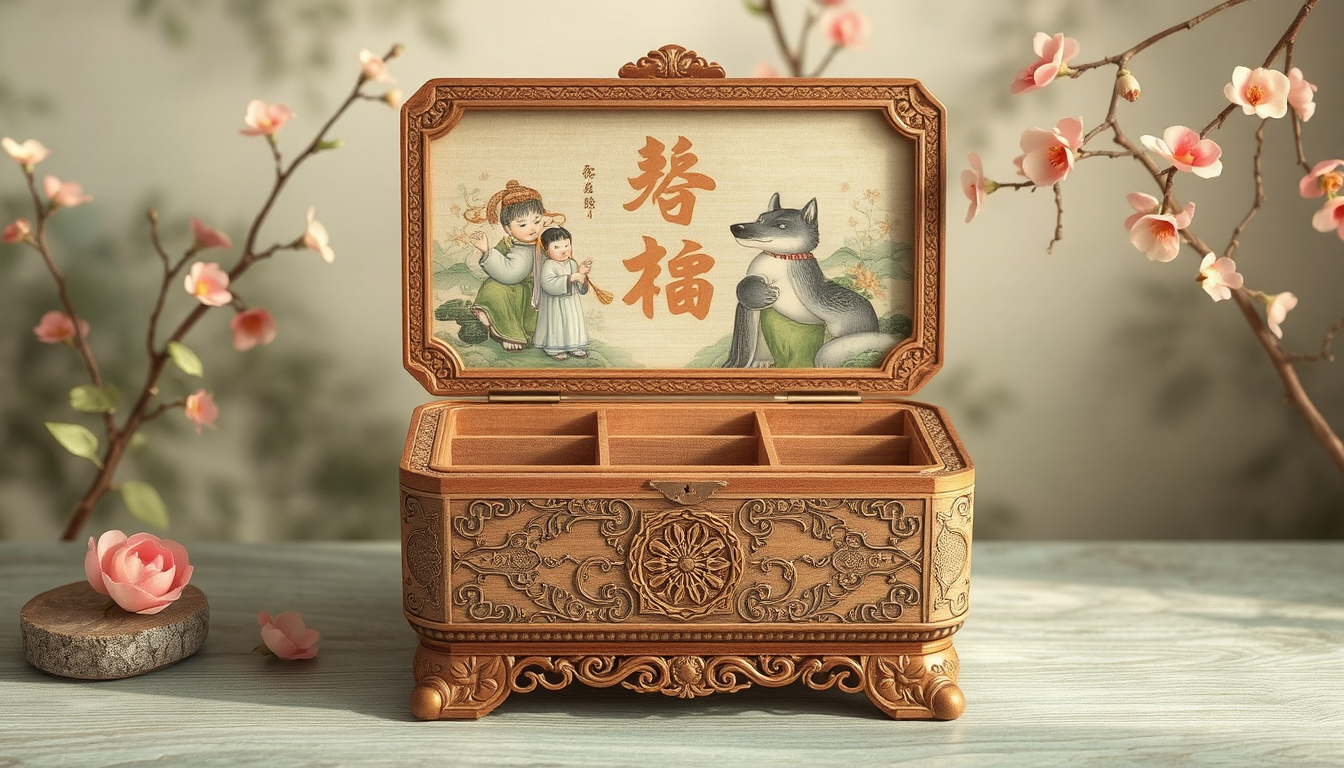
A well-made Chinese wood jewelry box can last for generations with proper care. Follow these simple steps:
- Gentle Dusting: Use a soft, dry microfiber cloth for regular cleaning. This removes dust without scratching the surface.
- Minimal Cleaning: If dust buildup is a problem, you may dampen a soft cloth ever so very slightly with distilled water and possibly a tiny drop of mild soap. Wring it until almost dry. Test on a hidden spot first as always.
- Polishing with Care: Avoid modern spray furniture polishes, which can damage the finish over time. If the wood looks dry, use a high-quality paste wax no more than once a year. Apply very thinly and buff gently.
- Hardware: Do not rub the brass hardware. It has established a patina that is part of its history and worth. Just a quick wipe and you are good to go.
- Environmental Control: Don’t let your box get too much sunlight — it will fade the wood — and keep it away from heaters and heat sources, which can cause the wood to dry and crack.
Conclusion: A Timeless Piece of Functional Art in Your Home
A Chinese wood jewelry box is more than just a container. It shows amazing skill and patience.
Fashioned with the finest woods through traditional processes, engrained with meaningful symbols, and holding a story, it is a future family treasure. Whether it’s been in your family for generations, or whether you’ve only recently acquired it, it’s functional art that transcends time, a link to a legacy of exquisite craftsmanship.
FAQ
- What woods are traditionally used in authentic Chinese wood jewelry boxes?
10 Such writing scholars use rosewood, camphor wood, zitan (a kind of purple sandalwood) and elmwood, each type of wood having its own meaning and status. - How can you identify an authentic vintage Chinese wood jewelry box?
Seek solid wood with natural grain patterns, traditional joinery without nails, hand-cut brass hardware with patina and aged silk or paper linings. - What do the symbols carved on Chinese wood jewelry boxes mean?
Widespread symbols include dragons (emperor//imperial power), phoenixes (empress/virtue) peonies (wealth), lotus flowers (happiness/purity), and pair of bats (happiness). - What is special about traditional Chinese woodworking techniques?
Chinese traditional boxes utilize interlocking joinery (sǔn mǎo), with neither nails nor glue to permit wood to expand and contract in humid conditions. - How should I care for my Chinese wood jewelry box?
Light dusting should be done with a dry microfiber cloth, avoid modern aerosol polishes, slot away from direct sunlight and sources of heat and use very sparingly cleaning with distilled water.


